
Ávila |
|

| Ávila de los Caballeros
(Latin: Abila and Óbila) is the capital of the province of the same
name, now part of the autonomous community of Castile and León,
Spain.
Ávila was the birthplace of
the 4th-century theologian Priscillian, the first Christian to be executed
for heresy. The town is more renowned for St. Teresa of Ávila, the
Carmelite reformer who lived there twelve centuries later (c. 1515-1582).
A convent and church mark the supposed birthplace of Santa Teresa, but
she was born in Gotarrendura in the Ávila province. Other prominent
natives include Saint John of the Cross, Tomás Luis de Victoria
and the Spanish-born American philosopher George Santayana. From 1482 to
1807 it was also the seat of a university.
Ávila is most known for the
medieval city walls, that were constructed of brown granite in 1090: surmounted
by a breastwork, with eighty-eight towers and nine gateways, they are still
in excellent repair, but a large part of the city lies beyond their perimeter.
The Gothic cathedral is integrated into the city's defences. It was built
between the 12th and 14th centuries, and has the appearance of a fortress,
with embattled walls and two solid towers. It contains many interesting
sculptures and paintings, besides one especially fine silver pyx, the work
of Juán de Arfe, dating from 1571. |

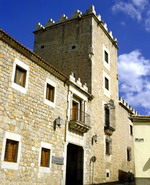 |
Parador
de Ávila, Ávila
In the historic quarter
of the sizeable town of Ávila, this Parador is installed within
the former "Piedras Albas" Palace, backing onto the impressive city walls.
In keeping with its surroundings, the hotel's interior has a warm and intimate
feel creating a very refreshing atmosphere, enriching your time spent there.
Its beautiful decorative features include granite and adobe floors, bright
colours and spacious rooms, some with four poster beds. These features
all combine to create a light feel to the rooms. The Parador also
features a garden containing archaeological remains, a magnificent glass-roofed
courtyard, partitionable function rooms and a cafeteria. The hotel's restaurant
provides a beautiful view over the gardens and the city walls. |

| Ávila
- Navarredonda de Gredos |
|

| Navarredonda de Gredos is
a municipality located in the province of Ávila, Castile and León,
Spain. According to the 2006 census (INE), the municipality has a population
of 469 inhabitants. |

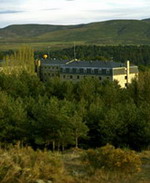 |
Parador
de Gredos, Navarredonda de Gredos, Ávila
The Sierra de Gredos has
housed this stone building since 1928, the first Parador, surrounded by
crystalline waters, rough rocks and green pine forests. The location in
Alto del Risquillo is a privileged vantage point over the Valle del Tormes,
the Gredos massif and the Piedrahita and Béjar sierras, making it
a real excursion centre. The hotelís tough stone walls hide an interior
with standout comfortable rooms, some with terrace. Classical wood reigns
in the dining room, library and lounges. The presence of granite columns
and the furnishing provide the space with a traditional Castilian style.
The quality of the meat and local vegetables and pulses - such as the famed
Barco beans - make for a rich cuisine of roasts and comfort soups and stews. |

Burgos
- Lerma |
|

| Burgos
- at the edge of the
central plateau, Burgos has about 170,000 inhabitants in the city proper
and another 10,000 in its suburbs. It is the capital of the province of
Burgos. Worth visiting - the Gothic Cathedral at Burgos, begun in
1221, displays features of the 13th to 15th centuries. Also visit
the Royal Monastery - Monasterio de las Huelgas - and Monasterio de Miraflores.
Lerma
- 36 kms from Burgos,
and 199 kms from Madrid. |

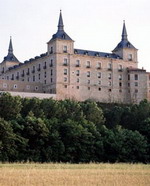 |
Parador
de Lerma, Lerma, Burgos Province
The Ducal Palace is located
in the highest part of the town of Lerma. It was constructed taking advantage
of the site of a 10th century castle. This hotel has a central courtyard
surrounded by columned galleries in alternating sections: the first has
twenty Tuscan columns with semicircular arches, and the second has twenty
Ionic columns. After its restoration the Palace has now been converted
into a Parador with 70 rooms and a capacity of 133 beds. The gastronomy
of the Parador is based on natural and tasty produce grown locally.
Of note are the cold meats such as the morcilla (blood sausage) and the
Burgos cheese ... |

León
City |
|

| León
- located in a flat countryside with wonderful historical and architectural
heritage. One of Leon's glories is without doubt, the Cathedral,
one of the finest in Europe and having been constructed from the 13th century
for a period of 200 years to completion. It has more than 250 remarkable
stained glass windows including a large rose window. In total there is
over 1800 square metres of glass. The cathedral museum is also worthy of
a visit with its wide array of exhibits. The Collegiate Church of
San Isidoro houses an impressive collection of early manuscripts. An early
Romanesque construction. The Palacio de los Guzmanes is a magnificent
16th century building with an impressive courtyard. The Casa de Botines
is an impressive piece by Gaudí with large turrets on each corner.
The Town Walls are of Roman and Medieval construction and are very impressive.
The San Isidro Tower is of particular interest. |

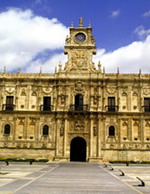 |
Parador
de León (Parador Hostal de San Marcos), León
The San Marcos Monastery,
whose construction began in the 16th century, replaced another 12th century
monastery from the times of King Alfonso VI. There are suites located
in the original building with views of the square and also an annex constructed
in the 20th century where the majority of the accommodation is housed.
Regal halls, spacious rooms, a library and a restaurant which in the main
part offers an impeccable traditional gastronomy with touches of signature
cuisine; all of which makes the Parador de San Marcos a unique establishment
on St. Jamesís Way and the Silver Way. Discover Leonese gastronomy
in the Rey Don Sancho restaurant. Saturate yourself with the finest flavours
of this historically plagued land enjoying the traditional local food washed
down with the excellent D.O. Bierzo and C.O. Tierras de León wines. |

Palencia
- Cervera de Pisuerga |
|

| Cervera de Pisuerga
- north
of the city of Palencia, in the foothills of the wonderful Picos de Europa
with astounding views. |

 |
Parador
de Cervera de Pisuerga, Palencia Province
The Parador de Cervera de
Pisuerga Hotel is set in a part of Fuentes Carrionas Reserve, determining
its most representative features. Nature can be seen in all its splendour
in the Picos de Europa and the blue waters of the Ruesga reservoir and
the Romanesque art, which here becomes the real protagonist of the landscape,
offering the site a unique and incomparable beauty. The hotel has
88 spacious and comfortable bedrooms, with bright balconies, combine with
the exquisite shade of walls, beams and ceilings covered with wood. The
restaurant offers traditional Castilian cooking based on hand-made sausages,
veal steak and trout with bacon. Also it ensures a peaceful and pleasant
stay for its guest during the visit. |

Salamanca
Province - Salamanca |
|

| Salamanca
- Salamanca is probably best known for having the oldest university in
Spain and one of the oldest in Europe. This university is still what gives
ambiance to the town. This charming town is untouched in it's architectural
purity. In central areas all recent buildings are constructed in Salamanca's
best tradition. The city has been declared "World Heritage Site" by UNESCO.
The city lies on a plateau by the Tormes river, which is crossed by a bridge
500 ft long built on 26 arches, fifteen of which are of Roman origin, while
the remainder date from the 16th century. |

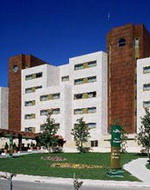 |
Parador
de Salamanca, Salamanca
The Hotel is on a small
hill on the left bank of the Tormes, facing the historic centre of the
city. Its large windows make it an exceptional lookout point over the city,
a living museum dominated by the cathedral towers. Elegance, comfort
and spaciousness characterise the hotelís public areas, meeting rooms and
bedrooms.
Tastefully decorated with marble and other luxurious materials, the interior
offers unbeatable views from all the lounges, the pool and most of the
rooms. Enjoy the local dishes of Salamanca offered in the Parador restaurant:
hornazo (meat pie), farinato and other Spanish sausages, cheese from Hinojosa,
tostón (sucking pig), Ledesma pastries and almond pastries. Delicious! |

Salamanca
Province - Ciudad Rodrigo |
|

| Ciudad Rodrigo
- located
on the River Agueda, 89 kms from Salamanca and 28 kms from Portugal, with
wonderful surrounding scenery. |

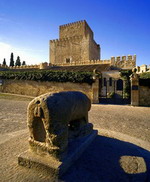 |
Parador
de Ciudad Rodrigo, Salamanca Province
The ivy-covered Hotel is
perched on a sheer drop over the River Águeda valley and the castle
has a keep which serves as an unbeatable observatory to look out over the
Campo Charro landscapes. This is the ideal enclave to discover the beauty
of the marvellous surrounding nature and appreciate the rich monumental
city of Ciudad Rodrigo. After the impeccable garden, the meticulous
period details, Castilian furnishings, the splendid patio and bright rooms
- some with exceptional views - are highlights. The stone arches
in the dining room are greatly admired, as are the typical Charro cuisine
with the standout local sausage - farinato - succulent roasts and Iberian
hams. |

Soria |
|

| Soria
- situated on the Rio
Duero in the east of the autonomous community, the city is noted for its
walls and a number of architecturally distinctive churches. These include
the Plateresque Concatedral de San Pedro and its cloister, the convent
church of Santo Domingo, and the unique architectural mix of the ruined
cloisters of San Juan de Duero, on the other side of the river from the
old town. A few kilometres north of the town are the ruins of Numantia,
a Celtiberian town whose inhabitants destroyed it rather than let it fall
to Scipio. In Soria is the Museo Numantino, devoted to the archeological
remains of this site. The city's professional football club is called CD
Numancia. |

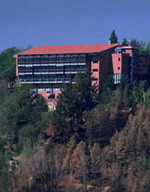 |
Parador
de Soria, Soria
The Parador de Soria rises
up on a privileged height from which the extraordinary panorama of this
monumental town and of the Duero river can be contemplated. The hotel
offers rooms that are provided with modern furnishing in pine wood and
are equipped with modern amenities. You can dine at the onsite restaurant,
which serves regional specialities in a cosy atmosphere. Conference
facilities are available for people on business travel. The area where
the parador is located enables guest to practise many activities such as
trekking, climbing, canoeing, guided routes and many others. |

Valladolid
Province - Segovia |
|

| Segovia
- after Toledo, SEGOVIA
is the outstanding trip from Madrid. A relatively small city, strategically
sited on a rocky ridge, it is deeply and haughtily Castilian, with a panoply
of squares and mansions from its days of Golden Age grandeur, when it was
a royal resort and a base for the Cortes (parliament). It was in Segovia
- in the unremarkable church of San Miguel, off the Plaza Mayor - that
Isabel la Católica was proclaimed queen. For a city of its size,
there are a stunning number of outstanding architectural monuments. Most
celebrated are the Roman aqueduct , the cathedral and the fairy-tale Alcázar,
but the less obvious attractions - the cluster of ancient churches and
the many mansions found in the lanes of the old town, all in a warm, honey-coloured
stone - are what really make it worth a visit. Just a few kilometres outside
the city and reasonably accessible from Segovia are two Bourbon palaces,
La Granja and Riofrío. |

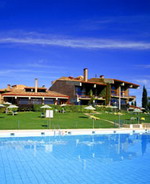 |
Parador
de Segovia, Segovia
Parador de Segovia Modern,
welcoming and surprising, this Parador rises up in one of the most monumental
cities of Spain, declared a World Heritage Site. From it can be seen the
best panoramic view of Segovia. It is moreover an ideal setting to approach
the numerous natural spaces of the province. The bedrooms of the
Parador are spacious and comfortable, and enjoy splendid views of the city,
as does the dining room and the outdoor swimming pool. The very spacious
lobby displays modern paintings and design elements, in clear contrast
to the simple, circular lines which frame the heated swimming pool. The
splendid conference centre stands out, with several living rooms and congress
rooms, and the dining room, an extensive display of regional products:
'judiones de La Granja' (beans), Castilian soup and roast lamb or suckling
pig in a wood-fired oven. |

Valladolid
Province - Tordesillas |
|

| Tordesillas
- a village in
the Valladolid province of Spain. It was the site where the most
famous Treaty of Tordesillas was concluded on 7 July, 1494 between Spain
and Portugal that divided the globe between the two kingdoms for purposes
of colonisation under the terra nullius-principle. The Main Square
(see right) is also the main place in Tordesillas, in which the public
activities have bean developed through the ages: markets, Middles Ages
Games, bullfights, concerts, comedies, meetings. Many monuments and
churches to be visited. |

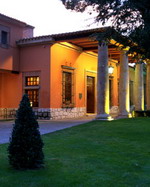 |
Parador
de Tordesillas, Valladolid Province
In the historic Castilian
city of Tordesillas, a crossroads since Roman times, stands this mansion,
in a green, natural landscape. A lovely wood of pines and a large, well
tended garden surround the hotel with the tranquil calm and serenity of
nature. The Castilian style dominates both the exterior and the interiors,
with valuable antique furniture in the lounges. The tranquillity of the
hotel and the spectacular blue of the pool invite one to relax and take
leisurely walks. Sit in the Paradorís dining room and enjoy its culinary
specialities: garlic soup, Castilian style roasts, free-range chicken Turresillano
style, and the local dessert, manjar de la Vega. |

Villafranca
del Bierzo |
|

| Villafranca del Bierzo
-
the last stage on the pilgrimage route in El Bierzo before reaching Galicia.
The settlement was developed from the pilgrimages. The river Burbia
flows through the town. Wonderful mountain landscapes all around. |

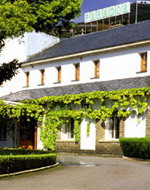 |
Parador
de Villafranca del Bierzo, León
This hotel can be found
in the extreme north of the Region of Castille-Leon in Villafranca del
Bierzo, capital of a very beautiful region and former station on the road
to Santiago. The rooms are situated on two floors of the main part
of the hotel. The wooden floor in the bedrooms and elsewhere offers elegance
and comfort. The cuisine typical of the town has its own specialities
such as; Trucha Con Unto (a trout dish), El Botillo del Bierzo, El Pulpo
a Barciana (an octopus dish) and Chanfaina barciana (a stew-like meal).
For dessert there are Los Suspiros De Monje (a mixture of flour, sugar
and egg). The landscapes of the Ancares mountain range to the north
complement the beauty of the Parador's garden. |

Zamora
Province - Benavente |
|

| Benavente
- A prominent town
located north of the capital on an important communications hub. The most
representative building in town is the Parador de Turismo Fernando II hotel,
which occupies the Caracol Tower, a 16th-century castle with wide segmental
miradors and a beautiful Mudejar coffered ceiling in the main section;
although it also has other attractions for the visitor, such as the church
of Santa María de Azogue, outstanding in which are the doors, some
multicoloured Gothic sculptures and several pillars; San Juan del Mercado,
with its prominent southern door; and the hospital of La Piedad, an old
pilgrims' hostel. |

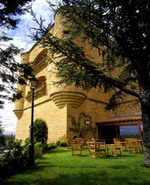 |
Parador
de Benavente, Zamora Province
This renaissance castle
was constructed under the order of Fernando II of León and was the
seat of las Cortes in 1202. It makes up part of the old town, set within
the town's ancient city walls. Surrounded by beautiful gardens, the castle's
interior has classical decorative features such as tapestries, forged lamps,
coffered ceilings, as well as Spanish bricks and woods. Its spectacular
rooms are specially equipped to be an ideal location for social gatherings.
The sleep-inducing bedrooms are cosy and accommodating, and the restaurant
offers local cuisine: Bacalao a la tranca (cod with boiled egg), arroz
a la zamorana (rice and pork dish), dos y pingada (fried egg and bacon
on bread) and tocino de cielo (custard caramel). |

Zamora
Province - Puebla de Sanabria |
|

| Puebla de Sanabria
- Lovely
area with hiking and green tourism routes and a historical and monumental
town, close to the Sanabria Lake. |

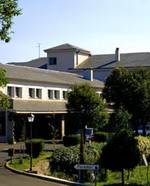 |
Parador
de Puebla de Sanabria, Zamora Province
The Hotel is in an exceptional
location just 12 km. from the wonderful Lake Sanabria, the biggest glacial
lake in Spain. In the centre of the Sanabria area, on the frontier with
Portugal, the Hotel is ideal for lovers of travel and nature, who come
to the area for green tourism excursions and tours, which are a delight
for the eyes and the spirit. The welcoming interiors, decorated with
care, offer quality and comfort for a pleasant stay. The lounge, with its
inviting fireplace, and some rooms offer large windows with views of the
outstanding historic town of Puebla de Sanabria. In the restaurant you
can enjoy exquisite habones (a local bean), trout and for dessert, a delicious
blackberry cake. All accompanied by local wines in a relaxing ambience
surrounded by nature. |

Zamora
Province - Zamora |
|

| Zamora
- a city in Castilla y Leon, and the capital of the province of Zamora.
It lies in the northwest, near the frontier with Portugal and crossed by
the Duero river. Many very beautiful medieval and Roman buildings,
churches and places to visit. |

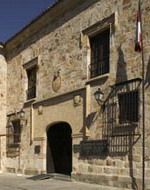 |
Parador
de Zamora, Zamora
In the historic centre of
the capital of the province, this hotel occupies a palace built over the
remains of a Roman fortress in the mid 15th century, and offers the traveller
an opportunity to discover the beauty of the landscape, both natural and
urban, of Zamora. The medieval flavour of the interior, with its
suits of armour, tapestries and attractive canopied beds, combines with
the Renaissance style of the courtyard, glazed wooden gallery and coats
of arms. The hotel has two halls for conventions and a swimming pool in
the flourishing garden. Wooden floors and beams give warmth to the baronial
decor. The restaurant offers excellent dishes from the traditional
local kitchen... |
Top
|

